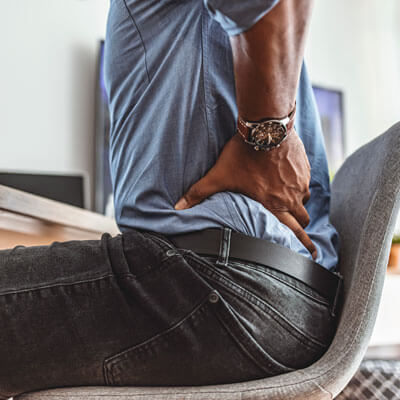 So, you woke up with a kink in your back; at the gym and felt a pop; bent down to pick up a box and something pulled, or maybe your back pain has been worsening for a while now, and you just don’t know what could be wrong. Well, you’re in luck. This article will be discussing the most common type of back injuries and how to go about treating them.
So, you woke up with a kink in your back; at the gym and felt a pop; bent down to pick up a box and something pulled, or maybe your back pain has been worsening for a while now, and you just don’t know what could be wrong. Well, you’re in luck. This article will be discussing the most common type of back injuries and how to go about treating them.
Most Common Back Issues and How to Treat Them
*Before committing to treatment for any of these ailments, consult a functional medicine practitioner or a chiropractor to determine the correct course of action.
- Muscle/ligament strain: can be caused by repeatedly lifting heavy weights, sudden awkward movements, and even by how you sleep. A muscle or ligament strain can cause painful spasms and tightness.
Treatment There are several natural remedies for strained muscles. One you can try incorporates the superfood, ginger. Try mixing a teaspoon of powdered ginger with a teaspoon of olive oil, another anti-inflammatory, and apply it to the problem area four to five times a day. Another anti-inflammatory substance includes cherry juice. The antioxidant and anti-inflammatory properties of the cherry juice will help relax muscles. There is also always the tried-and-true method of rest and hydration. With muscle strains, it’s important to get enough rest and to drink enough water to help the muscle heal faster. - Bulging/ruptured disc: discs are the cushions of tissue that sit between each vertebra. Discs can become more prone to damage as you get older, but when they move out of place and press on a nerve, the pain can be debilitating.
Treatment: Acupuncture, acupressure, and massage may relieve some pain until the bulging or ruptured disc is healed. Seeing a chiropractor, for spinal adjustments, can also be very helpful. A chiropractor can tell what type of bulging disc you have and can adequately target it with certain adjustments. Follow this with physical therapy, and you should find that your range of motion has increased and that your pain has decreased. Finally, stay as active as possible as a preventative measure. Keeping a strong core and maintaining a good range of motion is key to protecting your back. - Arthritis: Chronic inflammation of the joints that causes stiffness and swelling
Treatment: Lose weight. This will help improve mobility, decrease pain, and prevent further damage. You should also exercise to maintain the joints’ flexibility and strengthen the muscles around the joints for added support. Some exercises you can try are walking, cycling, tai chi, and swimming. - Osteoporosis: a disease in which bone mass decreases over time. This can lead to painful fractures and collapsed vertebra.
Treatment: The best way to prevent osteoporosis and mitigate its effects is to have a healthy diet and exercise. Your diet should consist of foods and supplements with calcium, magnesium, vitamin D, boron, strontium, and vitamin K. - Scoliosis: the abnormal curvature of the spine. Symptoms include uneven shoulders, different heights of rib cages, one or both sides of hips are higher than normal, the body “leans” to one side, and the head is not centered above the pelvis. Scoliosis can also cause pinched nerves.
Treatment: While scoliosis is incurable, there are steps that can be taken to minimize the spine’s unnatural curve and reduce pain. A natural approach to treating scoliosis includes a combination of disciplines like physical therapy, bracing, chiropractic care, exercises, and above an avoidance of surgery. - Sciatica: You have a sciatic nerve that runs the length of your lower back all the way down your leg. Sciatica is a result of sciatic nerve damage. You will experience pain, numbness, and/or weakness radiating from the lower back and down your leg.
Treatment: For the most part, sciatica resolves itself within a few weeks. However, there are things you can do to help manage the pain. Physical therapy is a great option, because not only does it promote recovery, but it will also help protect you from future injury. A few other options that have been known to manage sciatic pain are acupuncture, chiropractic care, and massage therapy. - Compression Fracture: Also called a collapsed vertebra. This occurs when there are too many cracks in your vertebra. If you have osteoporosis, you’re at risk if you smoke, have bone cancer, are very thin, and if you’re a woman over 50.
Treatment: Unfortunately, when it comes to compression fractures, all you can do is give your body time to heal. Rest and appropriate levels of guided physical therapy will help you heal faster and help strengthen your muscles to help prevent further injury. In some rare cases, surgery is recommended. - Spondylolisthesis: when the vertebra of the spine slides forward and over the vertebra below it. This squeezes the spinal cord, which causes severe pain. You may also lose feeling in your limbs, lose bladder control, and it may even make it difficult to walk.
Treatment: The treatment of spondylolisthesis is another case of simply managing the pain/symptoms. Acupuncture can help manage pain by releasing certain neurotransmitters. Natural herbal remedies such as devil’s claw, ginger, and white willow bark are great for treating inflammation.
How We Can Help
For many of these conditions, you’ll be able to see any one of our functional medicine practitioners. From chiropractors, to nutritionists, and physicians, we have specialists in fields like prenatal care, muscle injury, and fitness. If you believe you are suffering from a chronic injury, book an appointment today!
CONTACT US »
